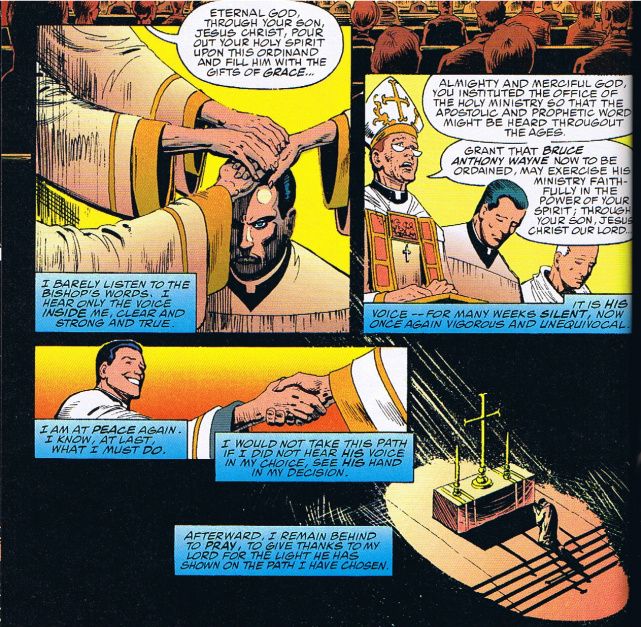
One of our favorite comic books is called "Batman: Holy Terror." That's it up top, courtesy of Mother Gillian and her mad librarian skillz. Set in an alternate reality, one on which some odd form of Christianity -- a highly liturgical Calvinism, we believe -- runs the government, the comic features a masked vigilante whose secret identity is a priest. It is quite possible that the page reproduced here, drawn by Norm Breyfogle, is our all-time favorite page of any comic book ever published: the ordination of Bruce Wayne.*
We mention all this because the United Methodist Church is struggling to discern its organizational future, and some voices seem to argue that what it really needs is a Dark Knight, a la Christopher Nolan -- an individual who, when the system fails, is willing to do whatever needs to be done, even if that means looking like the villain.
At least that's the interpretation of Jeremy Smith, in this article describing the four proposed models for restructuring the UMC's national leadership. Smith himself doesn't seem to think that the Dark Knight model -- meaning, somewhat anticlimactically, no more than a powerful executive -- reflects "the Methodist way." He believes that, just as Roman Catholics in trouble turn to their monastic orders, so Methodists ought to turn to representative democracy.
We don't know enough about Methodism to comment. But we do hereby offer our service to the first church body that actually elects Batman as its bishop.
________________________________________________
*Where credit is due: "Holy Terror" was written by Alan Bennett and drawn by Norm Breyfogle; the scan here is lifted from Scans Daily.

3 comments:
Using my mad librarian search skilz:
Here's the ordination:
from here:
Feh! I think Blogger stripped out the code! If you email it to me, I'll post it in a heartbeat.
Allowing myself to be more serious that the fun of Bishop Batman.... I read Jeremy Smith's article with interest. Like you, I don't know Methodism well enough to comment on the specifics of Smith's article. But the general challenge for a denominational body sounded familiar, and a couple of general thoughts occurred to me:
1) There seems to be a fairly common impulse in the face of declining church membership and budgets to turn the problem into one of church body structure. But while church leaders may have some influence on the fortunes of the body as a whole, it seems to me that the real efforts to address such issues are and need to be at the congregational level. Church body structure (while there may be real problems that need to be solved there, too, and is certainly not unimportant to the life of a church) is something of a sideshow. Organizational structure changes address a different, but often related, set of problems.
2) The proposal from the Methodist's official team, at least as briefly presented in Smith's essay, reminded me in certain ways of the ELCA's own LIFT proposals. There is a common centralization of control into a smaller group. It's not so much a change in structure as it is a focusing of power onto a smaller group. No doubt, it is thought that this will allow "tough" decisions to be made more easily.
At least in the case of the LIFT proposals passed last year in the ELCA, it seemed to me it was moving the furniture around, and putting some of it into storage. There really wasn't any re-imagining of how the church would function. It's still a staff centered model (even if that staff is significantly smaller) and a rather corporate model for governance (and even more so after the LIFT stuff is implemented going forward). It doesn't seem to really address the issues facing church bodies here and now.
Post a Comment